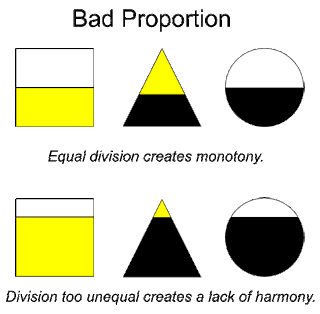This youtube video gives a brief idea of the application of basic design principles via Coca Cola print advertisements. The design principles discussed in the video are explored with reference to design texts.
 |
| Image Source: http://rafianimates.blogspot.com/2007/10/shapes-silhouettes. |
Balance/Symmetry
According to Lidwell, Holden and Butler (xxxx, p.234), symmetry is defined as ‘a property of visual equivalence among elements in a form’ and has been regarded as a basic element ‘found in virtually all forms of nature.’ They can be further classified into reflection, rotation, and translatio’. Symmetry is considered as ‘the most basic and enduring aspect of beauty’. Balance is a basic skill of design in achieving symmetrical figures which attributes to the recognition and memory of the image.
 |
| Image Source: http://www.bluemoonwebdesign.com/art-lessons-7.asp |
Proportion
According to Elam (2001, p.5), proportion is one of the ‘visual princeiples of geometric composition’ and ‘classic porportioning systems (include) the golden section and root rectangles’. Indeed, proportion is defined as the relativity between size and scale between elements in a design. For instance, proportion can be considered between the height, width and length of one element against the over composition.
Sequence
Sequence refers to the technique that is ‘used to connect elements that are not otherwise obviously grouped’ (Lidwell, et al, 2010, p. 246). An instance is the use of a connecting line to guide the audience’s viewing pattern.
 |
| Image Source: http://donswaim.com/wcbsnewsradio88.html |
Unity
Lauer and Pentak (2008, p.28) states that unity ‘means that a congruity or agreement exists among the elements in a design’ or simply, making different elements appear as if they ‘belong together’.
References
Elam, K 2001, Geometry of design: studies in proportion and composition, Princeton Architectural Press, New York
Lauer D A, Pentak S, 2008 Design Basics, Thomson Wadsworth, Boston
Lidwell W, Holden K, Butler J, 2010, Universal Principles of Design: 125 Ways to Enhance Usability, Influence Perception, Increase Appeal, Make Better Design Decisions and Teach through Design, Rockport, Beverly
USCJOUR364, 2009, Principles of Design - Group 16, video, YouTube, 14 October, viewed 7 Feb 2011,<http://www.youtube.com/watch?v=5tSued2AfhA&feature=related>
